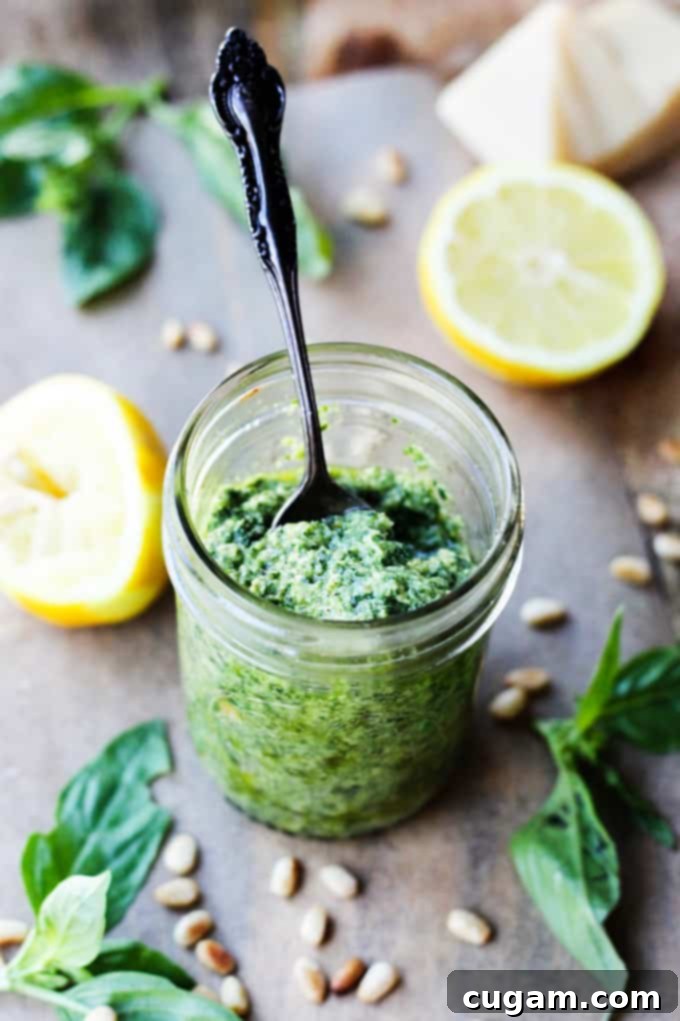Easy Homemade Lemon Basil Pesto Recipe: Fresh Flavors & Versatile Uses
If your garden is currently overflowing with an abundance of fragrant basil, you’re in for a delightful culinary treat! This **AMAZING Lemon Basil Pesto** offers the perfect solution for transforming your generous harvest into a vibrant, flavorful sauce that promises to elevate countless dishes. Forget the pre-made jars from the store; crafting your own fresh pesto at home is surprisingly simple and delivers a taste that is truly unparalleled and bursting with garden-fresh goodness. It pairs effortlessly with your favorite pasta dishes, perfectly complements grilled chicken or delicate fish, and shines in many other culinary applications. What’s more, with our easy-to-follow freezing instructions, you can effortlessly preserve any leftovers, ensuring you have this delectable pesto ready at your fingertips whenever you desire a taste of summer, no matter the season!
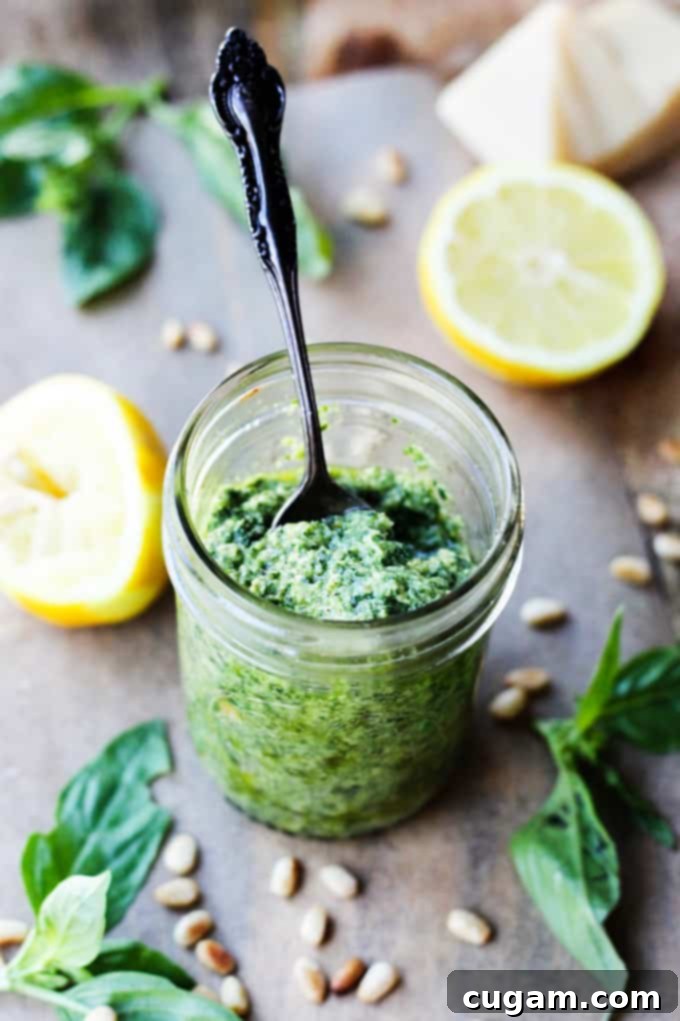
What is Lemon Basil Pesto? Understanding the Classic with a Citrus Twist
Most home cooks are familiar with classic pesto sauce, a culinary gem originating from the sun-drenched Liguria region of Italy. Traditionally, pesto, or “pesto alla genovese,” is a delightful and aromatic blend of essential ingredients that combine to create a deeply satisfying experience. These core components include:
- Generous amounts of fresh **basil leaves**, which form the aromatic heart of the sauce;
- Delicate pine nuts, adding a subtle, buttery texture;
- Pungent garlic, providing a foundational warmth and sharpness;
- Salty, aged Parmesan cheese (ideally Parmigiano-Reggiano), offering depth and umami; and
- Rich, fruity extra virgin olive oil, which binds all the flavors together into a smooth emulsion.
This traditional blend creates a bold, aromatic, and incredibly satisfying sauce that has been cherished for centuries. However, in this particular **basil pesto recipe**, we introduce a delightful and refreshing twist: the invigorating addition of fresh lemon zest and bright lemon juice. This isn’t just a minor tweak; it’s a transformative enhancement! Lemon is widely celebrated for its ability to brighten and amplify the inherent flavors of other ingredients, and its effect here is nothing short of magical. It effectively cuts through the richness of the olive oil and cheese while simultaneously infusing the pesto with an incredible layer of vibrant freshness.
While a classic basil pesto is undoubtedly fantastic and boasts a pretty bold flavor profile in its original form, the subtle yet powerful lemon twist in this recipe truly adds an additional depth, complexity, and a zesty zing that makes it stand out. The harmonious interplay of citrus notes provides a beautiful counterpoint to the herbaceous basil, resulting in a more complex and utterly addictive flavor profile. Trust me on this – one taste, and you’ll agree that this Lemon Basil Pesto is out of this world delicious and will quickly become a cherished staple in your culinary repertoire!
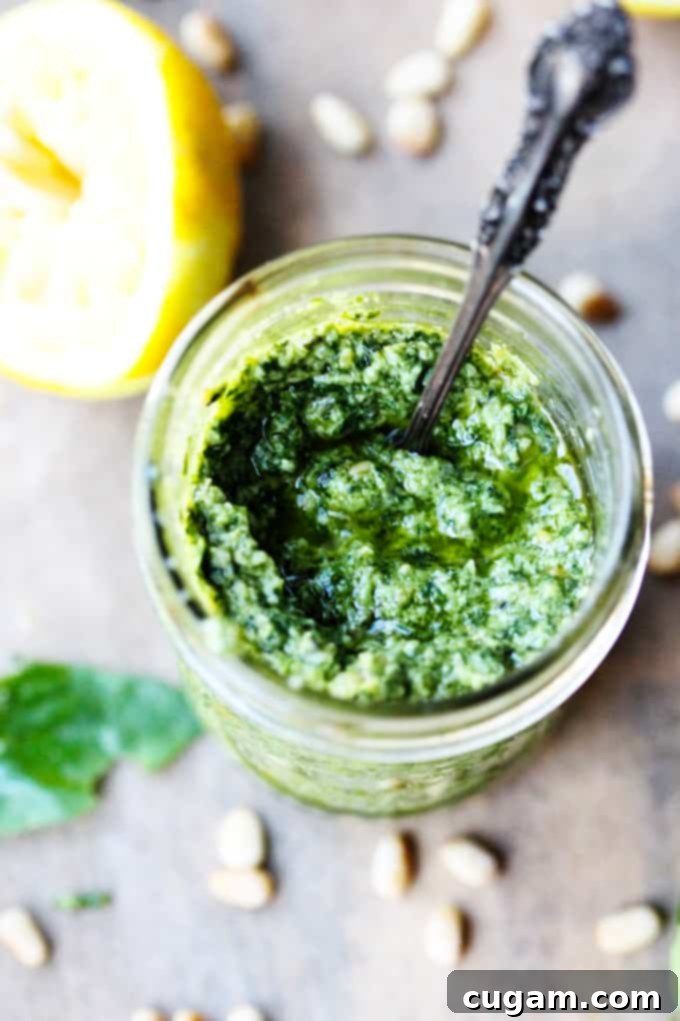
The Bright Benefits of Adding Lemon to Your Basil Pesto
You might be wondering, beyond just taste, what are the advantages of incorporating lemon into your basil pesto? The benefits extend far beyond a simple flavor enhancement, contributing to both the aesthetic appeal and the longevity of your homemade sauce:
- Flavor Amplification and Brightness: Lemon’s natural acidity acts as a flavor enhancer, making all the other ingredients—from the peppery basil to the sharp garlic and salty Parmesan—pop with even more intensity. It brightens the overall profile, preventing the pesto from tasting flat or overly rich, especially with the generous amount of olive oil.
- Preservation of Vibrant Color: One of the most common challenges with homemade pesto is preventing the basil from oxidizing and turning an unappetizing brown. The citric acid present in lemon juice acts as a natural antioxidant, effectively slowing down this oxidation process. This means your homemade pesto will maintain its beautiful, vibrant green color for a significantly longer period, making it more appealing both visually and gastronomically.
- Aromatic Zest and Depth: The lemon zest, specifically, is packed with essential oils that contribute a delightful, fragrant citrus note without making the pesto overtly sour. It’s that subtle, aromatic ‘je ne sais quoi’ that elevates this recipe from merely good to truly extraordinary, adding a layer of sophisticated flavor.
- Balances Richness: The refreshing tang of lemon perfectly balances the inherent richness of the extra virgin olive oil and the salty, umami depth of the Parmesan cheese. This careful balance results in a harmonious and well-rounded flavor profile that keeps you coming back for more.
Furthermore, using fresh, high-quality ingredients, particularly basil harvested directly from your garden, makes an immense difference in the final product. Garden-fresh basil is typically far more aromatic and intensely flavorful than most store-bought varieties, contributing to a truly superior, more authentic pesto experience.
How to Make This Vibrant Lemon Basil Pesto: A Simple Step-by-Step Guide
Creating this lemon-infused basil pesto is remarkably straightforward and requires minimal effort, making it a perfect recipe for both novice and experienced cooks. All you really need is a reliable food processor or a sturdy blender and just a few minutes of your time. The secret to achieving a perfect, restaurant-quality pesto lies in the careful order of adding ingredients and ensuring a smooth, beautifully emulsified texture without the risk of over-processing. Here’s your simple, step-by-step guide to whipping up your own delicious batch of this incredible sauce:
- Step 1: Combine the Core Flavors and Pulse. Begin by adding your fresh basil leaves (ensure they are thoroughly washed and dried), the peeled garlic clove, the roasted pine nuts, fresh lemon zest, fresh lemon juice, a pinch of salt, and a dash of black pepper into the bowl of your blender or food processor. Pulse these ingredients initially using short bursts. This method is crucial as it helps to chop the solid components evenly and, importantly, prevents the delicate basil leaves from bruising and turning dark, which can occur if blended continuously too soon. Continue pulsing until you achieve a nicely chopped, coarse mixture, but don’t overdo it.
- Step 2: Gradually Emulsify with Olive Oil. Once the initial ingredients are well-chopped and integrated, begin to gradually stream in your high-quality extra virgin olive oil through the feed tube while the blender or food processor is continuously running. The slow addition of the oil is key to allowing it to emulsify properly with the other ingredients. This process is what creates that signature thick, smooth, and luxuriously creamy pesto texture we all love. Continue streaming the oil until the pesto reaches your desired consistency – it should be thick enough to cling beautifully to pasta, yet still have a pourable quality.
- Step 3: Gently Incorporate the Cheese. For the final touch, add the freshly grated Parmesan cheese to the mixture. At this stage, you only need to pulse the food processor or blender just a few more times until the cheese is fully incorporated into the pesto. It’s crucial not to over-mix after adding the cheese, as continuous blending at this point can sometimes lead to a grainy texture or an overly oily separation in the pesto.
And just like that, in mere minutes, you have a fresh, intensely flavorful, and completely homemade Lemon Basil Pesto ready to enhance your meals! It literally cannot get any easier than that to create such an exquisite sauce, right?
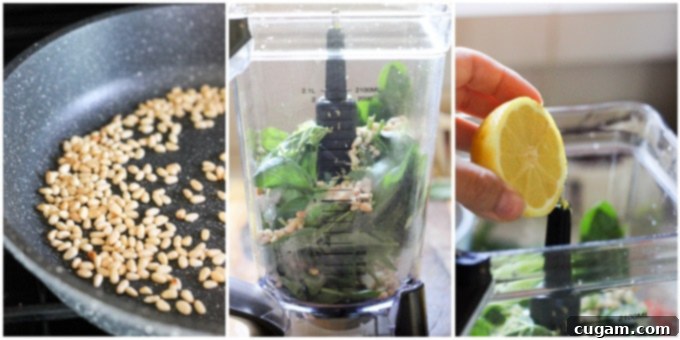
Ingredient Spotlight: Maximizing Flavor with Quality Components
While the process of making pesto is wonderfully simple, the ultimate flavor and quality of your final sauce are profoundly influenced by the ingredients you choose. Investing in good quality components and preparing them properly will make a significant difference. Here are some detailed tips for selecting and preparing the best ingredients for your Lemon Basil Pesto:
- Basil Leaves: The absolute foundation of your pesto. Always prioritize using fresh basil. For the most aromatic and flavorful results, select vibrant green leaves that are completely free from any blemishes, wilting, or dark spots. Before adding them to your food processor, gently wash the basil and, crucially, dry them thoroughly. Any residual water can dilute the flavor and make your pesto watery and less intense.
- Garlic: One medium-sized clove is typically sufficient to provide a balanced, fragrant warmth without overpowering the other flavors. However, if you are a true garlic enthusiast and prefer a more pronounced kick, feel free to add a little extra, always adjusting to your personal taste. Ensure your garlic is fresh and peeled.
- Pine Nuts: These traditional nuts are revered for their delicate, buttery flavor and soft texture, which are integral to classic pesto. Lightly toasting them in a dry pan over medium heat for just a few minutes until they become lightly golden and fragrant is a game-changer. This simple step significantly enhances their natural nuttiness, adding an extra layer of depth to your pesto. Just be vigilant to prevent them from burning, as they can go from toasted to burnt very quickly.
- Parmesan Cheese: For an authentic and superior taste, freshly grated Parmigiano-Reggiano is indispensable. Its complex, salty, and distinctly umami notes are absolutely essential for achieving that characteristic authentic pesto flavor. Pre-grated cheeses often contain anti-caking agents that can affect texture and lack the nuanced flavor of freshly grated.
- Extra Virgin Olive Oil: As one of the primary ingredients, your choice of olive oil matters immensely. Select a high-quality, flavorful extra virgin olive oil. Its rich, fruity, and often slightly peppery notes will shine through in the final pesto, contributing significantly to its overall character.
- Lemon: Always use a fresh lemon for both the zest and the juice. The zest is particularly important as it contains concentrated essential oils that impart a more intense and aromatic lemon flavor than juice alone. The fresh juice, on the other hand, provides the necessary acidity to brighten and balance the sauce.
- Salt & Pepper: These seasonings are crucial for bringing out all the flavors. Start with the suggested amounts in the recipe and then, after the initial blend, taste your pesto and adjust the salt and freshly ground black pepper to your exact preference.
Can I Substitute Any Other Greens Instead of Basil?
Absolutely! While the resulting sauce wouldn’t technically be a “basil” pesto, the true beauty and adaptability of pesto lie in its incredible versatility. You can create a myriad of delicious and unique pesto variations by using a wide range of different greens, or even clever combinations of them. Experimenting with various leafy greens can genuinely open up a whole new world of exciting flavor profiles, allowing you to customize your pesto to suit different dishes and personal preferences!
Here are some fantastic suggestions for alternative greens that work wonderfully in pesto:
- Parsley Pesto: Offers a distinctly fresh, clean, and slightly peppery flavor. This variation is particularly excellent when paired with lighter dishes such as grilled fish or used as a bright sauce for chicken.
- Cilantro Pesto: Provides a wonderfully bright, citrusy, and subtly pungent taste. It’s an ideal choice for adding a unique twist to Mexican or various Asian-inspired culinary creations.
- Arugula Pesto: Delivers a delightful spicy and peppery kick that adds an exciting edge to the sauce. It pairs exceptionally well with grilled meats, adds zing to roasted vegetables, or makes a fantastic sandwich spread.
- Spinach Pesto: A much milder option, spinach pesto is perfect for those who prefer a less intense herbaceous flavor. It’s also a clever and delicious way to incorporate more greens into meals, especially for children.
- Kale Pesto: Known for its earthy and robust flavor, kale pesto is hearty, nutritious, and incredibly satisfying. For the best texture, many find it beneficial to blanch the kale leaves briefly before blending.
- Mint Pesto: Offers a uniquely refreshing and cool flavor. Surprisingly versatile, mint pesto is exceptionally good with specific dishes like lamb or certain light pasta preparations, adding an unexpected brightness.
You can also get creative by combining basil with some of these other greens. For instance, a blend of basil and arugula pesto would offer a wonderful balance between the sweet, aromatic notes of basil and the pleasant, peppery bite of arugula, resulting in a more nuanced and complex flavor profile.
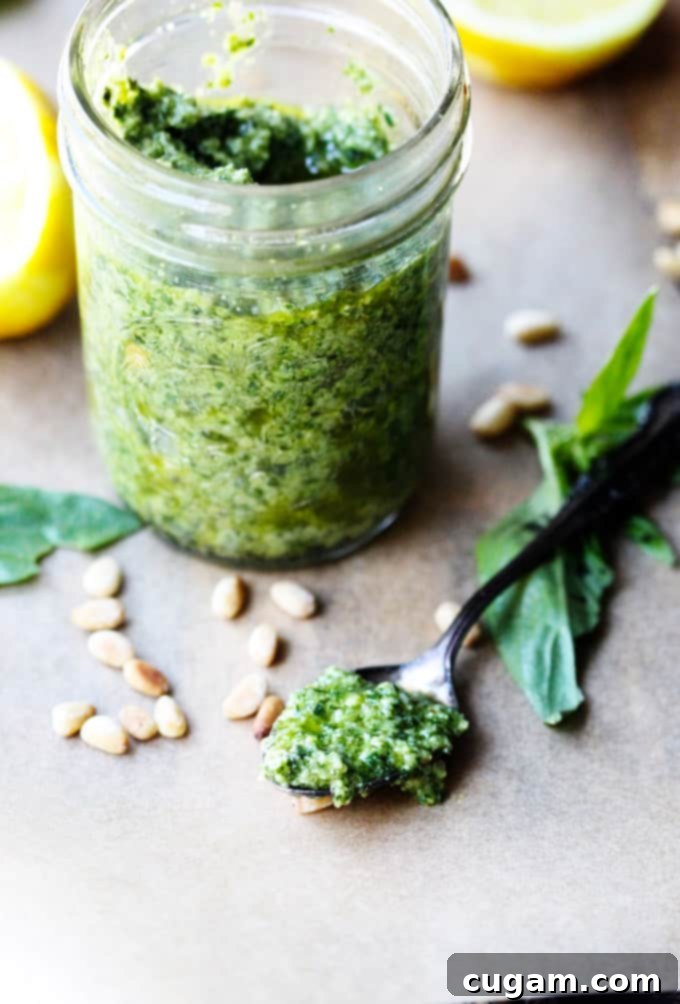
Pine Nuts Too Expensive or Hard to Find? Discover Excellent Alternatives!
I completely empathize with the struggle! Pine nuts can indeed be quite expensive, and they aren’t always readily available in every grocery store. While they certainly contribute a unique, delicate, and buttery flavor to traditional pesto, there are numerous excellent and more budget-friendly alternatives that can work just as wonderfully, if not better, to achieve a fantastic texture and delicious taste in your homemade pesto.
I often have luck finding reasonably priced pine nuts at specialty stores or retailers like Trader Joe’s, and I typically opt for their roasted variety to ensure an enhanced flavor. If I purchase raw pine nuts, I make it a point to give them a quick toast. This involves spreading them in a dry frying pan over medium heat for just a few minutes until they achieve a light golden color and release their inviting, fragrant aroma. This simple, quick step significantly deepens their flavor profile, making a noticeable difference in the final pesto.
However, if pine nuts remain out of reach or simply too costly, don’t despair! Here are some fantastic and widely available alternatives you can confidently use:
- Walnuts: These are a very popular and classic substitute for pine nuts. Walnuts offer a slightly more robust, earthy flavor that stands up well in pesto. To bring out their best, toast them briefly in a 350°F (175°C) oven for approximately 5-7 minutes until they are satisfyingly crunchy and aromatic.
- Almonds: Blanched almonds, or even slivered almonds, work wonderfully in pesto, providing a milder, buttery flavor and a smooth texture when blended. Just like walnuts, toasting them in the oven for a similar duration will yield a much richer and more profound taste.
- Cashews: If you’re aiming for a creamier, slightly sweeter pesto, cashews are an excellent choice. They blend incredibly smoothly, contributing a luscious, rich texture to your sauce. A light toast will also enhance their natural sweetness and depth.
- Pecans: These nuts offer a distinct, buttery, and slightly sweet flavor that can introduce an interesting and unique twist to your pesto, adding complexity.
- Sunflower Seeds or Pumpkin Seeds (Pepitas): For those seeking a nut-free or allergy-friendly option, toasted sunflower seeds or pumpkin seeds can provide a similar crunch and an appealing earthy flavor. Ensure they are unsalted if you’re toasting them yourself.
Regardless of which nut or seed you ultimately choose as your base, remember this crucial tip: a quick toast before blending will invariably enhance the flavor, aroma, and overall deliciousness of your homemade pesto, making it even more irresistible!
Can I Freeze Pesto Sauce? The Best Way to Preserve That Garden-Freshness!
Yes, absolutely! And this is truly one of the most incredible and practical features of homemade pesto. Making a generous batch and then carefully freezing it ensures that you can savor the vibrant, fresh flavors of summer basil long after the season has passed. Freezing pesto is remarkably easy, incredibly effective, and offers a fantastic solution for preventing any food waste from an abundant basil harvest, allowing you to enjoy your delicious creation for months to come.
Here’s my top suggestion for efficiently freezing pesto to maximize both its freshness and your future convenience:
- Utilize Ice Cube Trays: The most convenient method is to spoon your freshly made lemon basil pesto into standard ice cube trays. This ingenious approach allows you to freeze the pesto in perfect, single-serving portions, which are ideal for tossing with an individual serving of pasta, adding a flavor boost to soups, or spreading onto sandwiches.
- Flash Freeze for Solidity: Once the trays are filled, place them carefully in the freezer for a few hours. Allow the pesto cubes to freeze completely solid; this is crucial for easy removal and prevents them from sticking together later.
- Transfer to Freezer Bags: After the pesto cubes are thoroughly frozen and solid, pop them out of the ice cube trays. Transfer these frozen cubes into a heavy-duty, freezer-safe ziploc bag or an airtight freezer-safe container. This protects them from freezer burn and preserves their flavor.
- Label and Store Appropriately: Always remember to add a date to the bag or container with a permanent marker. This helps you keep track of when you froze the pesto. For optimal flavor and quality, store your frozen pesto for up to 3-4 months. While it might remain safe to eat for a longer period, the quality and vibrant taste can diminish after this time.
- Prevent Browning (Optional but Recommended Tip): To further help maintain that beautiful, vibrant green color and to prevent surface oxidation, consider pouring a very thin layer of extra virgin olive oil over the pesto in each ice cube compartment before placing the trays in the freezer. This creates a protective seal that shields the pesto from air exposure.
When you’re ready to enjoy your preserved pesto, simply take out the desired number of frozen pesto cubes and let them thaw gently in the refrigerator overnight, or at room temperature for a shorter period. You can also add the frozen cubes directly to warm pasta, hot soups, or simmering sauces; they will melt and integrate beautifully, making dinner incredibly simple and efficient!
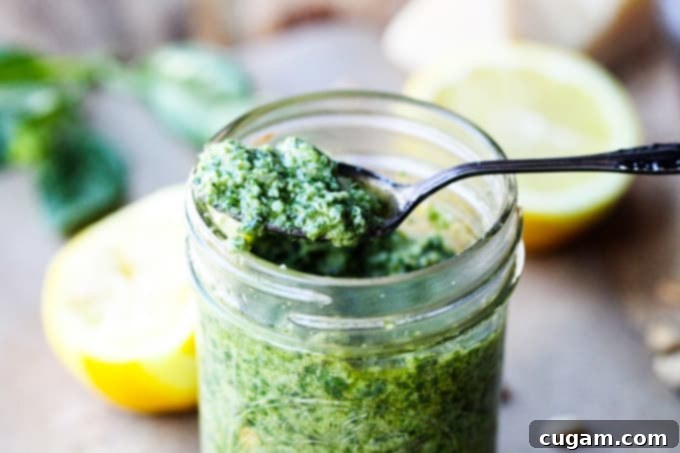
What to Serve This Versatile Lemon Basil Pesto Sauce With? Endless Culinary Possibilities!
The true charm of this Lemon Basil Pesto lies in its remarkable versatility. Its bright, herbaceous, and delightfully zesty flavor profile is an extraordinary complement to an incredibly wide array of dishes, making it an indispensable staple to always have on hand in your kitchen. Whether you’re aiming for a quick and easy weeknight dinner, preparing an impressive meal for guests, or simply looking to infuse a burst of fresh flavor into your everyday cooking, this vibrant pesto consistently delivers. Here are just a few inspiring ideas to ignite your culinary imagination:
- Pasta Perfection: This is, without a doubt, the quintessential pairing! Simply toss your freshly cooked spaghetti, penne, fettuccine, farfalle, or any other pasta shape with a generous dollop of pesto for an incredibly quick, satisfying, and flavorful meal. Keep an eye out for a perfect pesto pasta recipe coming soon to the blog!
- Roasted Chicken or Magic Faux-Tisserie Chicken: Utilize the pesto as a flavorful marinade before roasting your chicken, brush it on as a vibrant glaze towards the end of the cooking process, or simply spoon it as a fresh sauce over your perfectly cooked chicken pieces for an exquisite burst of flavor.
- Veggie Burgers & Sandwiches: Elevate your next veggie burger by spreading a generous layer of this pesto on the bun, or incorporate it as a sensational condiment in any sandwich, wrap, or panini for an instant and dramatic flavor upgrade.
- Grilled Shrimp or Fish: Transform ordinary seafood into a gourmet delight. Marinate shrimp or delicate fish fillets in the pesto before grilling, or simply spoon it generously over freshly grilled seafood for an exquisite and bright burst of flavor. It pairs particularly well with options like salmon, cod, or flaky white fish.
- Baked Eggs with Tomatoes and Pesto: A truly delightful, easy, and incredibly flavorful option for breakfast, brunch, or even a light dinner. Swirl a spoonful of pesto into your baked eggs for an incredible savory and herbaceous twist.
- Pesto Zucchini Noodles: For a lighter, low-carb, and incredibly fresh meal, gently toss your spiralized zucchini noodles with this vibrant pesto. Add some juicy cherry tomatoes and a sprinkle of extra Parmesan cheese for a complete and satisfying dish.
- Italian Antipasto Skewers: Drizzle this flavorful pesto generously over your Italian antipasto skewers. It adds an enticing layer of authentic, bright Italian flavor, enhancing all the individual components.
- Roasted Vegetables: Give your roasted vegetables an instant flavor boost! Toss warm roasted potatoes, sweet carrots, tender broccoli, or colorful bell peppers with a spoonful of pesto immediately after they come out of the oven.
- Soups & Stews: Stir a tablespoon or two of this pesto into a hearty minestrone, a comforting vegetable soup, or a rich stew just before serving. It introduces an unexpected layer of freshness and aromatic depth.
- Pizza & Flatbreads: Get creative by using this pesto as a unique and flavorful base sauce for your homemade pizzas or flatbreads, offering a delightful alternative to traditional tomato sauce.
- Dips & Dressings: For a quick and delicious dip, mix the pesto with some Greek yogurt, sour cream, or cream cheese. Alternatively, thin it out with a little extra olive oil and lemon juice to create a vibrant, homemade salad dressing.
As you can see, the culinary possibilities are truly endless with this delightful Lemon Basil Pesto! It acts as a culinary chameleon, adapting beautifully to elevate an incredibly diverse range of dishes. If you decide to make this recipe, I would absolutely love to hear from you. Please share your thoughts on how you liked it and, more excitingly, what amazing creation you chose to serve it with, by leaving a comment below. I’m always looking forward to seeing new and inspiring ways that you enjoy this recipe!
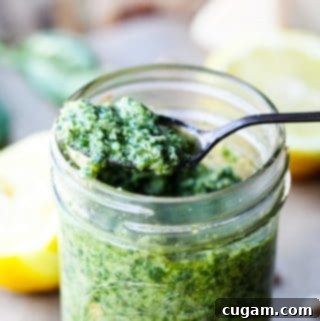
Lemon Basil Pesto
Print
Pin
Rate
Ingredients
- 2-3 cups Basil Leaves packed;
- 1 clove Garlic peeled;
- 1/3 cup Pine Nuts roasted;
- 1/3 cup Parmesan Cheese grated;
- 1/2 cup Olive Oil Extra Virgin
- 1/2 Lemon juiced and zested;
- 1/2 teaspoon Salt
- 1/4 teaspoon Black Pepper freshly grounded
Instructions
-
In a blender or food processor add basil leaves, garlic, pine nuts, lemon zest, lemon juice, salt and pepper and pulse until nicely chopped;
-
While the motor is running gradually add olive oil until the pesto is thick;
-
At the end add Parmesan Cheese and pulse until just incorporated (don’t over-mix it at this point). Enjoy with your favorite pasta, chicken or fish.
Nutrition
Conclusion: Your Go-To Lemon Basil Pesto Recipe
This Lemon Basil Pesto recipe is truly more than just a simple sauce; it’s a vibrant celebration of fresh, invigorating flavors and an ingenious, practical way to make the absolute most of your abundant basil harvest. With its bright, zesty citrus notes beautifully complementing the rich herbaceousness of basil, the pungent kick of fresh garlic, and the satisfying richness of nuts and cheese, it stands as a truly exceptional homemade condiment. Whether you’re in a hurry to whip up a quick and flavorful weeknight dinner, meticulously preparing a special meal to impress, or simply looking to add an extraordinary burst of fresh flavor to your everyday cooking, this pesto consistently delivers outstanding results every single time. Remember, its allure lies in its incredible ease of preparation, its impressive versatility across countless dishes, and the simple convenience of being able to freeze it for future enjoyment.
We genuinely encourage you to try this fantastic recipe and personally discover the magic of homemade lemon basil pesto for yourself. We are always thrilled to hear about your culinary adventures and see your creative serving ideas, so please don’t hesitate to share your thoughts and experiences in the comments section below! We eagerly look forward to seeing all the delicious and inspiring ways you choose to enjoy this vibrant recipe!
More Italian Recipes You’ll Love:
- Penne Alla Vecchia Bettola
- Easy Shrimp Scampi Spaghetti
- Italian Rice Salad with Tuna
- Italian Antipasto Skewers
- Margherita Pizza
Read more about the author Edyta here or follow Eating European on social media: Facebook, Instagram, Pinterest and Twitter.
[mc4wp_form id=”6774″]
